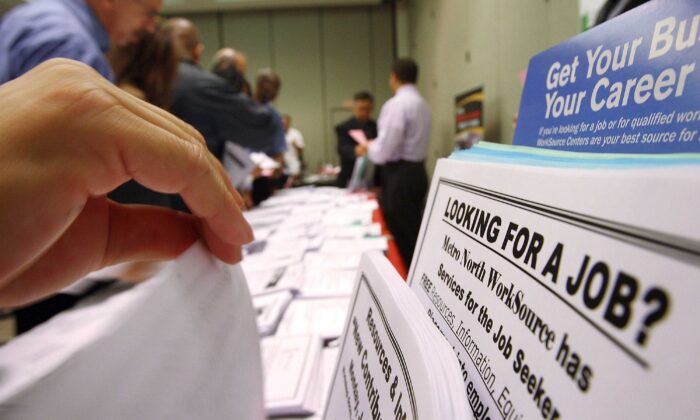By Bryan Jung
Americans filing continued unemployment claims rose to their highest level in five months, while initial jobless claims fell to their lowest level since June, according to the Labor Department on Sept, 1.
Continuing claims, which run a week behind jobless claims data, rose to 1.44 million on Aug. 20, up 26,000 from the previous week, to levels not seen since April.
The number of Americans filing for jobless benefits for the first time fell, from 237,000 to 232,000, for the week ended Aug. 27.
This was below the Dow Jones estimate of 245,000 and the lowest number of jobless claims since June 25.
“Initial jobless claims edged lower in the last week while continuing claims rose slightly. No signs of a major shift in labor market despite growing layoff announcements,” wrote Kathy Jones, chief fixed income strategist at Charles Schwab Corp. in a tweet.
States like New York, Massachusetts, and Michigan saw the biggest filings in jobless claims, while Connecticut, Missouri, and Oklahoma saw the biggest drop in claims last week.
Meanwhile, the four-week moving average for initial claims, which smooths out weekly volatility, fell from 245,500 to 241,500, a seven-week low.
All of these data come ahead of the awaited Sept. 2 release of the payrolls report for August.
Investors are predicting that job gains in August, which is a normally volatile month for employment figures, will total 318,000 in the payrolls report.
Labor Market Remains Stable for Now
So far, the jobs market remains tight, despite 40-year high rate of inflation and elevated mortgage rates, as hiring demand and consumer spending remain stable, amid worries of a recession.
The U.S. Bureau of Labor Statistics (BLS) report, on Aug. 30, showed that the number of job openings remains relatively stable at 11.2 million positions, with two jobs for every available worker.
Many companies are raising wages and offering bonuses, as they compete for available workers in a tight labor market.
New data from Institute for Supply Management (ISM), released on Sept. 1, showed a spike in manufacturing jobs in August, after three straight months of declines, reinforcing a need for more workers.
However, other companies, such as Walmart and Redfin, are laying off workers or are planning to reduce their workforce, as their respective industries witness profit loss.
ADP’s private sector report, released on Aug. 31, showed that companies added only 132,000 jobs last month, which is well below average, but many economists are convinced that job growth remains solid.
“Our data suggest a shift toward a more conservative pace of hiring, possibly as companies try to decipher the economy’s conflicting signals,” said Nela Richardson, chief economist at ADP.
ADP also reported that annual pay was up 7.6 percent last month.
The Labor Department said the unit labor costs rose 10.2 percent for the third quarter, while rising 9.3 percent over the last four quarters, the highest level since early 1982.
Inflation and the Federal Reserve
Revised productivity numbers in a separate BLS report from Sept. 1 showed that the decline in productivity in the second quarter was less severe than reported.
Productivity levels showed only a drop of 4.1 percent, which was better than the 4.6 percent from the initial reading.
The Federal Reserve has been attempting to balance the tight jobs market while trying to curtail inflation with a series of hikes in the interest rate, and has raised its policy rate by 225 basis points since March,
However, the aggressive central bank policies have raised the risk of a recession, with few signs that higher borrowing costs have cooled down the demand for more workers.
Several Fed officials recently indicated the rate increases are likely to continue, with another hike expected in September.
Meanwhile, Loretta Mester, president of the Federal Reserve Bank of Cleveland, said that the federal funds rate, the benchmark rate used between banks for overnight lending, will likely rise above 4 percent by early 2023.
“My current view is that it will be necessary to move the fed funds rate up to somewhat above 4 percent by early next year and hold it there,” Mester said during a speech in Dayton, Ohio, on Aug. 31.
“I do not anticipate the Fed cutting the fed funds rate target next year.”
The fed funds rate is also tied to many consumer debt instruments.
Reuters contributed to this report.






